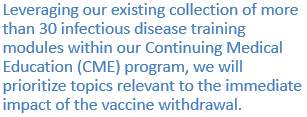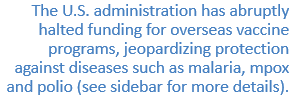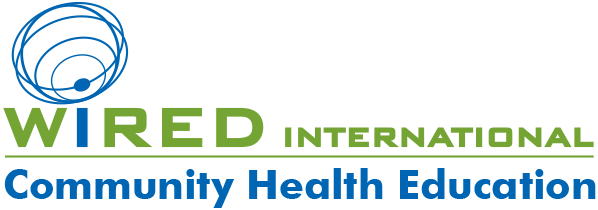By Gary Selnow, Ph.D., and Allison Kozicharow; Edited by Elizabeth Fine
Background
Recently, we reported on WiRED International’s efforts to equip community health workers (CHWs) to support HIV/AIDS patients deprived of antiretrovirals (ARVs) due to abrupt U.S. government funding cuts to USAID. These life-saving medications, though inexpensive, are now tragically inaccessible, soon leading to widespread suffering and death in underserved regions. In response, WiRED, a health education organization, swiftly developed a training module for treatment protocols, providing CHWs with tools to manage the devastating symptoms as patients succumb to AIDS.
When Vaccines Are Gone
 The U.S. administration has abruptly halted funding for overseas vaccine programs, jeopardizing protection against diseases such as malaria, mpox and polio (see sidebar for more details). This decision dismantles U.S. support for Gavi, an international alliance that has delivered crucial vaccines to the world’s poorest nations since 2000. Coupled with U.S. withdrawal from the World Health Organization (WHO), this leaves vulnerable populations without essential intervention tools to prevent the spread of infectious diseases.
The U.S. administration has abruptly halted funding for overseas vaccine programs, jeopardizing protection against diseases such as malaria, mpox and polio (see sidebar for more details). This decision dismantles U.S. support for Gavi, an international alliance that has delivered crucial vaccines to the world’s poorest nations since 2000. Coupled with U.S. withdrawal from the World Health Organization (WHO), this leaves vulnerable populations without essential intervention tools to prevent the spread of infectious diseases.
WiRED’s Urgent Response
While WiRED, like other small NGOs, lacks the resources to replace the lost U.S. funding, we are committed to mitigating the consequences of vaccine shortages. Just as we did with the recent loss of ARVs due to U.S. budget cuts, we are preparing our CHWs to address the health crises resulting from the lack of vaccines.
 Leveraging our existing collection of more than 30 infectious disease training modules within our Continuing Medical Education (CME) program, we will prioritize topics relevant to the immediate impact of the vaccine withdrawal. This ensures that CHWs are prepared with critical information during community visits and Health Screening Clinics. Each module provides comprehensive details on disease signs, symptoms, prevention, diagnosis and treatment. CHWs will stress measures indivdiuals can take to minimize the risk of infection. This often is referred to as behavioral prevention.
Leveraging our existing collection of more than 30 infectious disease training modules within our Continuing Medical Education (CME) program, we will prioritize topics relevant to the immediate impact of the vaccine withdrawal. This ensures that CHWs are prepared with critical information during community visits and Health Screening Clinics. Each module provides comprehensive details on disease signs, symptoms, prevention, diagnosis and treatment. CHWs will stress measures indivdiuals can take to minimize the risk of infection. This often is referred to as behavioral prevention.
After their training refreshers, our CHWs will:
- Conduct widespread prevention education in public spaces, workplaces, schools and places of worship.
- Educate teachers, officials and community leaders about disease symptoms and reporting procedures.
- Maintain heightened vigilance during their regular rounds in the communities and the Health Screening Clinics to identify potential cases.
 With the withdrawal of U.S. financial support for Gavi, vaccines essential to healthcare in Africa are most likely to strike hardest at the following diseases. Accordingly, we anticipate focusing additional CHW training on modules that address these specific illnesses:
With the withdrawal of U.S. financial support for Gavi, vaccines essential to healthcare in Africa are most likely to strike hardest at the following diseases. Accordingly, we anticipate focusing additional CHW training on modules that address these specific illnesses:
- Cholera
- Diphtheria
- Ebola
- Hepatitis B
- Malaria
- Measles
- Mpox
- Pneumococcal diseases (PCV)
- Polio
- Rotavirus (severe diarrheal disease)
(Main source of information: https://www.afro.who.int/health-topics/immunization)
While we cannot provide vaccines, we can empower communities through education. WiRED’s CHWs, trained in health education and early detection, serve as crucial sentinels, identifying potential outbreaks before they escalate.
In the face of these devastating funding cuts, WiRED’s decades-long commitment to health education in underserved communities has never been more critical.
Calling All CHWs!
 We invite all CHWs, regardless of where they were trained, to join our free CME Tracker program. Using our HealthMAP app on Android devices, they can access dozens of infectious disease modules and hundreds of other educational modules to fulfill their annual CME requirements. All modules are available without cost for offline study; as with all WiRED CHW training programs, the CME Tracker is entirely free.
We invite all CHWs, regardless of where they were trained, to join our free CME Tracker program. Using our HealthMAP app on Android devices, they can access dozens of infectious disease modules and hundreds of other educational modules to fulfill their annual CME requirements. All modules are available without cost for offline study; as with all WiRED CHW training programs, the CME Tracker is entirely free.
Disease-specific Information CHWs Can Access through WiRED Modules Online or through HealthMAP
Vector borne:
Chagas disease
Chikungunya
Dengue
Lyme disease (bacteria)
Malaria (parasite)
Yellow fever (virus)
Food or water borne:
Cholera (bacteria)
Dysentery (bacteria or parasites)
Hepatitis (virus)
Typhoid fever (bacteria)
Polio virus
Direct or indirect contact:
Avian flu (bird flu) (virus)
Diphtheria (bacteria), also droplets
MERS (virus)
Conjunctivitis
Ebola
Lassa fever
Leptospirosis (bacteria)
Mpox (virus}
Rabies (virus)
Scabies (mites)
Sexually transmitted infections
Airborne:
Bronchitis (mainly virus)
Coronavirus (virus)
Influenza
Measles (virus), also direct contact
Pneumonia (bacteria)
Tuberculosis (bacteria)
Meningitis (bacteria or virus) (airborne, direct contact)
Rheumatic heart disease (through rheumatic fever) (bacteria)
Multiple modes of transmission:
URTI (direct and indirect contact and airborne)
Buruli ulcer (bacteria or virus) (vector, direct contact)
Meningitis (bacteria or virus) (airborne, direct contact)
Sepsis (complication of infection)
Zika virus



